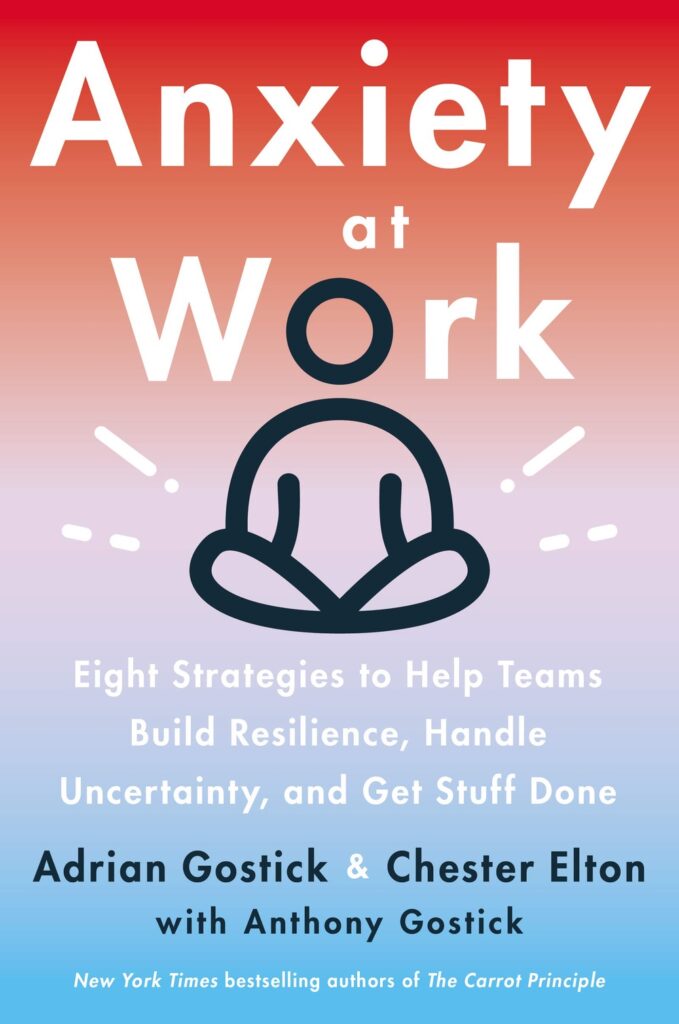Sharing my learnings from the book, Anxiety at Work by Adrian Gostick and Chester Elton
Anxiety at Work by Adrian Gostick and Chester Elton
Have you ever dreaded Sunday night, got a pit in your stomach on the way to work, or had your heartbeat speed up at the sound of your boss’s voice? If so, you may have had anxiety at work. In this empathetic and wise guide, executive coaches and gurus of gratitude Adrian Gostick and Chester Elton explore the causes of workplace stress and anxiety and the management practices that have proven successful in reducing tension and cultivating calm.
In today’s volatile, fast-paced, and ever-changing global climate, organizations and their employees are under more pressure than ever to perform. Anxiety at Workshows how everyone at all levels can work together to build an environment that fosters camaraderie, productivity, and calm.

- the modern workplace is full of the unknown (employees feel replaceable at any time). The key is for leaders to try and minimize uncertainty where they can – and help their employees cope when they can’t.
- The prospect of engaging in conflict with your teammates, or your boss, might make you highly anxious. But, there’s a big difference between healthy debate and unhealthy hostility in the office.
- Disagreement and debate among members of the highest-performing teams is common. This conflict drives better problem-solving and can actually motivate staff to produce better work.
- how can leaders encourage healthy debate within their teams?
- encourage discussions in meetings
- managers should emphasize the importance of everyone giving their honest opinion at all times.
- Managers can encourage a better quality of debate by encouraging employees to support their arguments with facts, whenever they express disagreement.
- the psychological distress that marginalized groups may feel at work. These groups include, but aren’t limited to, ethnic minorities, members of the LGBTQ+ community, and those affected by disability.
- leaders can become allies in the fight against discrimination and bias in the workplace
- important to follow up on all complaints in a timely manner, even the ones which appear to be minor
- leaders should foster an environment in which everyone feels comfortable expressing their true selves
- leaders can help promote a more authentic environment by sharing more about themselves, and modeling authenticity
- when workers feel like a cohesive group, they’re actually much more effective at their jobs.
- use regular one-to-one catch-up sessions to ask team members how they’re getting along with the rest of the team.
- adopting a routine known as the ten-ten. The ten-ten involves walking around their team’s office, with the goal of saying hello to everyone, and asking them how they’re doing.
- implement a buddy system.
- Bosses are placing greater demands on their employees and expecting them to do more in an ever-shrinking timeframe. But all these expectations are pushing workers over the edge.
- When you’re burned-out, you feel either physically or emotionally exhausted. You might start feeling cynical about your work and the people you work with; you may feel irritable, or even start to dislike yourself for putting up with other people’s unreasonable demands.
- what can companies do to tackle burnout?
- reducing their employees’ workload.
- reducing their employees’ digital workload, or reassigning form-filling to people on the team who actually enjoy these kinds of tasks, staff feel less anxious, and far less overwhelmed.
- Millennial workers fear missing out on better job opportunities.
- implementing development initiatives for their employees
- traditional training programs that are offered to all staff
- more creative initiatives, such as offering a fast route to promotion
- Perfectionist traits are causing yourself unnecessary anxiety at work.
- what can companies do to stop perfectionism becoming a source of anxiety among their employees
- let your employees know what good enough looks like.
- bosses need to be generous with their praise
- bosses to learn how perfectionism presents itself in the workplace, so that they can identify the people that might need extra reassurance


Leave a Reply